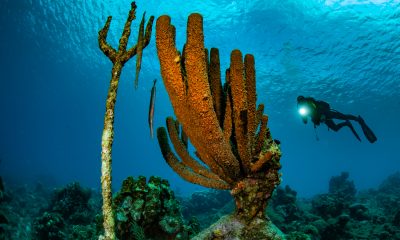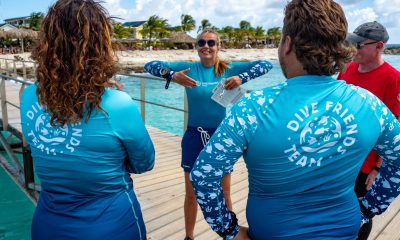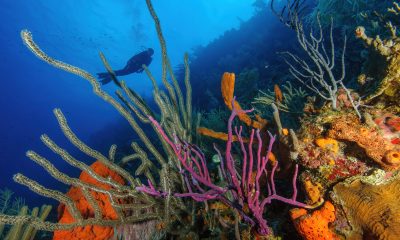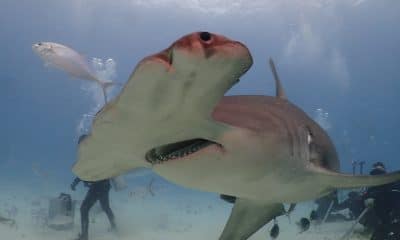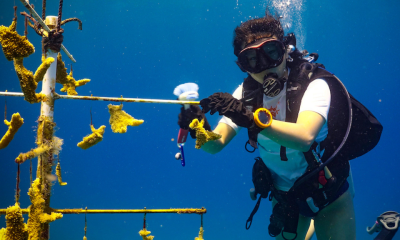News
Rare Caribbean coral grown in lab for the first time
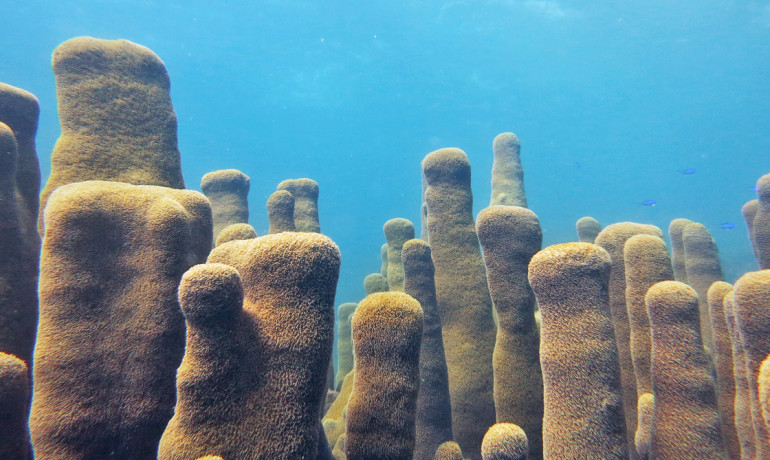
Caribbean pillar coral, a rare and threatened coral species, has been bred and raised in a lab by scientists for the first time.
The work provides the first photos and documentation of juveniles of this species, and could provide information to aid the conservation of coral reefs in the study area.
The team plans to “out-plant” these lab-grown juveniles in the wild, which could help populations become more resilient to climate change.
The Caribbean pillar coral Dendrogyra cylindrus is rare and understudied, and small juveniles of this species have never been seen in over 30 years of surveys in the Caribbean. The species is one of very few corals in the Caribbean that forms large branches which can provide shelter for important fish species and can reduce the energy of storm surge as it approaches shore.
“Strangely enough, pillar corals happen to spawn just half an hour before another threatened coral that is far better studied —t he elkhorn corals,” says Kristen Marhaver, lead author of the study and senior fellow at TED.
“So the reason why for so many years we’ve never witnessed spawning pillar corals is that while they were spawning, virtually all coral spawning researchers and photographers in the Caribbean were on their boats doing final preparations on their dive gear for elkhorn coral spawning. It was literally right under our noses for years.”
The findings were presented at a TED Conference in Vancouver, Canada last night, and also appears in the journal BMC Ecology. Mónica Medina, associate professor of biology at Penn State, is a coauthor of the study.
‘SMOKE STACK’ CORALS
Pillar corals form a unique “smoke stack” shape like no other coral species, and they display unusual mating behavior compared to most spawning coral species. Most spawning corals are hermaphrodites that release large bundles of eggs and sperm.
Pillar corals, which spawn only on a few specific nights of the year, build colonies that are either all male or all female. The males first release sperm into the seawater, shortly followed by the females releasing their individual eggs. This timing makes collection and breeding research extremely difficult.
“Now that we’ve successfully reared juvenile pillar corals in the lab, not only can we study them in more detail to find out what factors could be threatening their survival in the wild, but it also means that we can try to out-plant a small number back to the reef,” says Marhaver, who began this work as a postdoctoral researcher at the University of California.
“We don’t know if this will work and it is certainly not a cure-all for the reef. But especially in such a rare coral species, a tiny boost of a few new individuals could make a big difference in their genetic diversity, allowing their populations to adapt and become more resilient to the changing environment in the oceans.”
AFTER THE FULL MOON
After studying the sunset times and lunar cycles taken from other spawning observations, the research team timed their egg and sperm collection around the most likely annual spawning times — exactly three nights after the August full moon and around 100 minutes after sunset.
At depths of roughly 20-22 feet on a Curaçaoan coral reef with a large population of pillar corals, the team arranged nets and funnels over the female colonies to automatically collect eggs, and used syringes near the male colonies to manually collect sperm from spawn clouds as they appeared.
The team then attempted to fertilize the eggs by mixing the collected eggs and sperm underwater and on shore.
In the lab, the team carefully adjusted several factors related to fertilization times and seawater type and nurtured the eggs to develop into larvae. The scientists managed to successfully grow the embryos to the swimming larvae stage—the first time this have ever been seen—and settled them onto ceramic tripods in water tanks. The settled juveniles then survived for over seven months.
HOW TO PROTECT CORALS
Now that they have determined how best to grow these coral in the lab, work can begin on studying how different factors affect their survival. By testing in the lab the effect of water type, contaminants, or the presence of different species of animals and bacteria, the scientists may be able to translate these findings to the wild, and explain why juvenile pillar corals are missing in certain areas.
This research may help to support the protection of local coastal areas. Populations of branching coral colonies often are identical genetically, making them extremely susceptible to threats such as disease and temperature shock. The team therefore plans to return a few lab-reared juveniles to the reef to see if they will grow and help jump-start the population’s genetic diversity.
This work could help the species to adapt and to become more resilient to threats such as climate change. Evidence is growing that juvenile corals can adjust better than adult corals in some places to changing environments. The introduction of new juveniles to the reef, therefore, could help buffer these ecosystems against global threats that affect all corals.
“Given how rare the juveniles are in nature, it was a bit of a question whether the species was still reproducing at all,” says Marhaver. “Corals can also reproduce by fragmentation, so a huge field of pillar corals could in fact be from one single parent colony and might not be able to reproduce.
“Now that we have some of the first solid evidence that they are still able to reproduce, it means we can be cautiously optimistic about the future of this threatened species.”
Source: www.futurity.org
Photo: Kristen Marhaver
Gear News
Go anywhere with Stahlsac
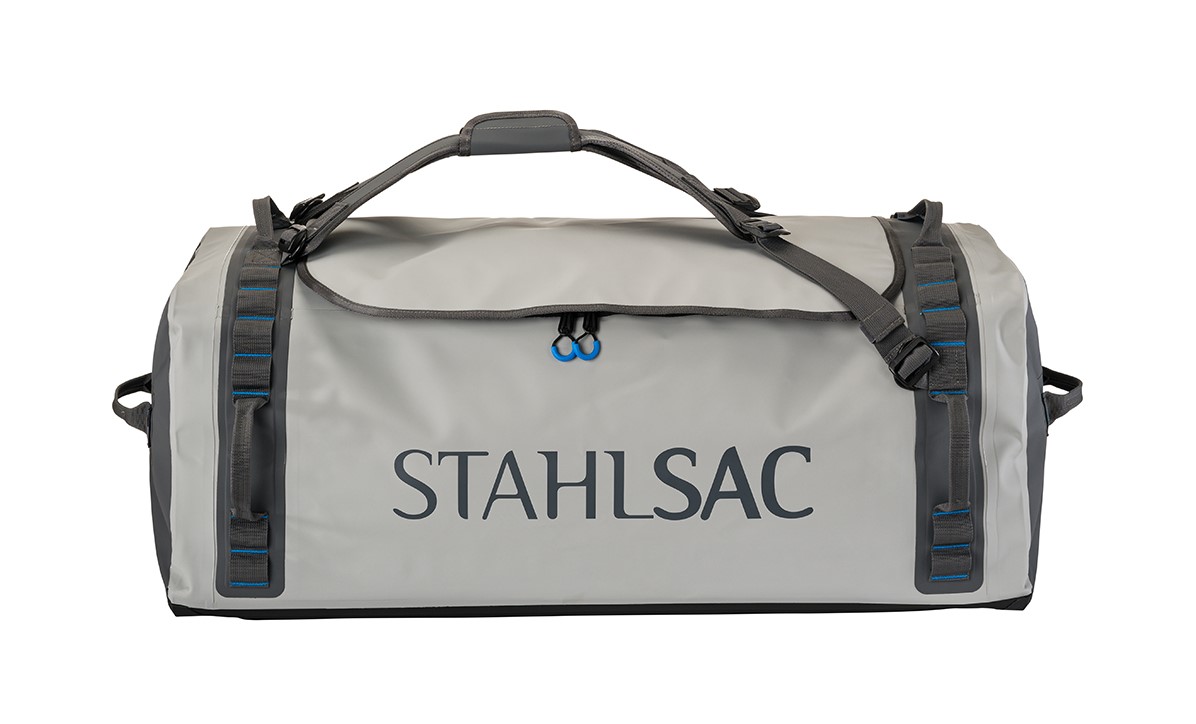
Stahlsac dive bags and travel luggage are built for our community of divers, surfers, kayakers and outdoor explorers who need bags that are constructed with durability, toughness, and 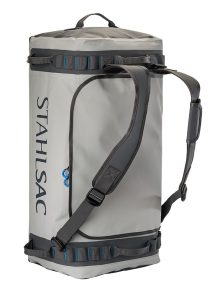 the highest quality the industry has ever seen. We were founded by one man determined to build better watersports and dive bags, and today, that mission is carried on by many. Adventure doesn’t just present itself; it requires discovery. When we design dive bags, we make sure they are tough enough for you to explore in all conditions—warm and cold, wet and dry—to the nearest and farthest reaches of the earth. And for those times you want to push the boundaries of adventure, Stahlsac dive bags make sure you can truly GO ANYWHERE.
the highest quality the industry has ever seen. We were founded by one man determined to build better watersports and dive bags, and today, that mission is carried on by many. Adventure doesn’t just present itself; it requires discovery. When we design dive bags, we make sure they are tough enough for you to explore in all conditions—warm and cold, wet and dry—to the nearest and farthest reaches of the earth. And for those times you want to push the boundaries of adventure, Stahlsac dive bags make sure you can truly GO ANYWHERE.
Abyss Duffels
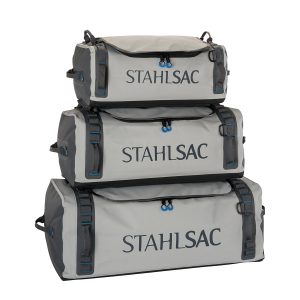 Made to be your partner-in-crime on every adventure, Stahlsac’s Abyss Duffels protects your gear from Mother Nature’s worst. Tough and 100% waterproof with double-TPU nylon material that shrugs off daily wear-and-tear, and RF-welded seams further boost the bag’s potential for lifelong exploring. Get Wet. Get Lost. Go Anywhere with Abyss.
Made to be your partner-in-crime on every adventure, Stahlsac’s Abyss Duffels protects your gear from Mother Nature’s worst. Tough and 100% waterproof with double-TPU nylon material that shrugs off daily wear-and-tear, and RF-welded seams further boost the bag’s potential for lifelong exploring. Get Wet. Get Lost. Go Anywhere with Abyss.
- A weatherproof duffel for trips, travel, and adventure
- Ultra-durable double-TPU nylon protects your gear
- Material repels water and keeps your equipment dry
- RF-welded seams are flush, tough, and waterproof
- Removable straps transform duffel into backpack
- Zippered internal stow compartments carry essentials
- External zippered flap is easy to open and close
- Welded external handles make transporting a breeze
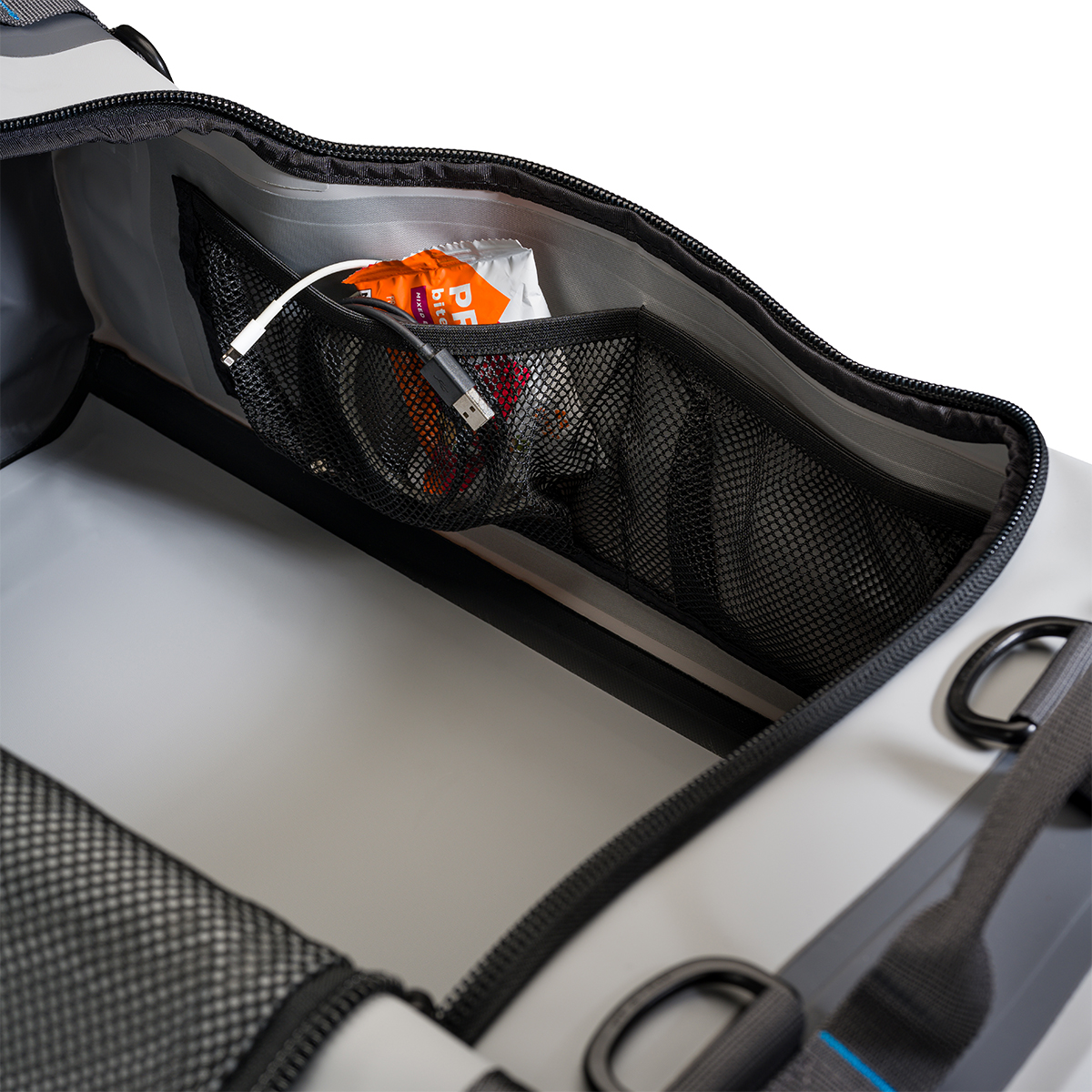
Panama Mesh Backpack
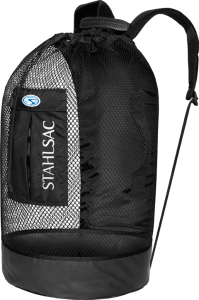 The most copied design in scuba diving, the Stahlsac Panama Mesh Backpack is the “original” design and features two high-density foam padded shoulder straps, extra durable polyester mesh, duffel bag handles and our unique zippered dry pocket inside that combines with a wet pocket outside. The bottom’s built from reinforced 18-gauge PVC nylon to combat the wear and tear of your active coastal lifestyle, and, as a bonus in every bag, we supply a 12″ x 12″ mesh drawstring satchel for extra stowing utility. Pack up your beach kit and go.
The most copied design in scuba diving, the Stahlsac Panama Mesh Backpack is the “original” design and features two high-density foam padded shoulder straps, extra durable polyester mesh, duffel bag handles and our unique zippered dry pocket inside that combines with a wet pocket outside. The bottom’s built from reinforced 18-gauge PVC nylon to combat the wear and tear of your active coastal lifestyle, and, as a bonus in every bag, we supply a 12″ x 12″ mesh drawstring satchel for extra stowing utility. Pack up your beach kit and go.
- Density foam padded shoulder straps
- Outside wet/dry pockets
- 2 Carry handles
- Tough, snag-resistant polyester mesh
- Reinforced PVC bottom
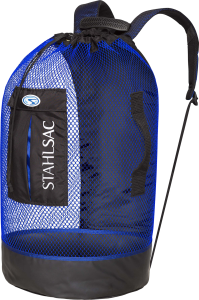
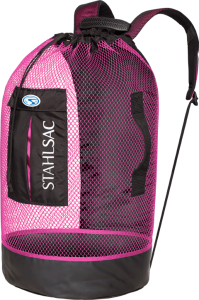
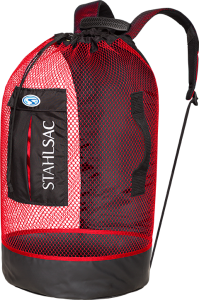
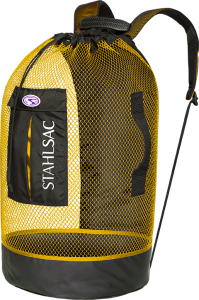
For more information about Stahlsac bags, visit www.stahlsac.com/dive-bags.
Sea & Sea is the home of Stahlsac and other leading diving brands in the UK.
Blogs
EXCLUSIVE: Jeff Goodman interviews Mark Spiers, CEO of New Scuba Diving Training Agency NovoScuba

In a video recorded exclusively for Scubaverse.com, Jeff Goodman interviews Mark Spiers, CEO of new scuba diving training agency NovoScuba.
Find out more about NovoScuba at www.novoscuba.com.
-

 News3 months ago
News3 months agoCapturing Critters in Lembeh Underwater Photography Workshop 2024: Event Roundup
-

 Marine Life & Conservation Blogs3 months ago
Marine Life & Conservation Blogs3 months agoCreature Feature: Swell Sharks
-

 Blogs2 months ago
Blogs2 months agoMurex Resorts: Passport to Paradise!
-

 Gear Reviews3 weeks ago
Gear Reviews3 weeks agoGEAR REVIEW – Revolutionising Diving Comfort: The Sharkskin T2 Chillproof Suit
-

 Blogs3 months ago
Blogs3 months agoDiver Discovering Whale Skeletons Beneath Ice Judged World’s Best Underwater Photograph
-

 News2 months ago
News2 months agoPADI Teams Up with Wellness Brand Neuro to Drive Ocean Change and Create a Blue State of Mind
-

 Gear Reviews3 months ago
Gear Reviews3 months agoGear Review: Oceanic+ Dive Housing for iPhone
-

 News3 months ago
News3 months agoWorld’s Best Underwater Photographers Unveil Breathtaking Images at World Shootout 2023



